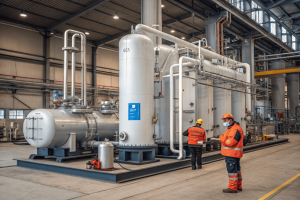What is CO2 recovery from biogas plant?
•
What is CO2 recovery from biogas plant?
Your biogas is only about 60% methane. The other 40% is CO₂, a non-combustible gas that you have to scrub out. You are venting a potentially valuable product into the atmosphere.
CO₂ recovery from a biogas plant is the process of separating the carbon dioxide from the methane. This "upgrades" the biogas into high-purity biomethane (RNG) and simultaneously captures the CO₂, purifying it into a liquid, food-grade co-product for sale or use.

I find these projects incredibly rewarding. We take organic waste, which produces a mixed gas, and with one system, we create two distinct, high-value products. The plant starts selling pipeline-quality gas and food-grade liquid CO₂. This completely changes the economics of anaerobic digestion. It’s a perfect example of turning a waste stream into multiple revenue streams.
What are the main components of an industrial CO₂ recovery plant?
You need to plan a project, but the equipment list seems complex. It's hard to budget or allocate space without a clear picture of the essential hardware and how it all connects.
The main components are an inlet compressor, a purification system with filters for contaminants like H₂S, a multi-stage compressor, a dehydration unit, activated carbon filters, a liquefaction unit (refrigeration), and a cryogenic storage tank.
When I walk an engineer through a new plant design, I describe it as a production line for gas. Each component has a specific job to do, taking the raw CO₂ and refining it step-by-step. If one component is not sized or specified correctly, the whole line is affected. Getting this hardware train right is the key to producing a consistently high-purity product efficiently.
The Hardware Production Line
Each piece of equipment builds on the work of the last, progressively cleaning and changing the state of the CO₂ gas until it becomes a stable, pure liquid.
| Component | Primary Function | Why It's Essential for Biogas |
|---|---|---|
| Inlet System | Collects the raw CO₂ stream after it has been separated from methane. | This is the starting point. The quality of this feed gas determines the subsequent workload. |
| Primary Purification | Removes major contaminants, especially corrosive Hydrogen Sulfide (H₂S). | H₂S is toxic and can damage equipment. Removing it first is a critical safety and maintenance step. |
| Multi-Stage Compressor | Increases the pressure of the CO₂ gas to the level required for liquefaction. | High pressure is necessary to turn a gas into a liquid at achievable temperatures. |
| Dehydration Unit | Removes water vapor from the compressed gas. | Prevents ice from forming in the liquefier, which would block the system and stop production. |
| Activated Carbon Filters | Adsorbs remaining volatile organic compounds (VOCs) and other trace impurities. | This is the final "polishing" step to meet stringent food-grade purity standards. |
| Liquefaction Unit | Uses a refrigeration system to chill the pure, high-pressure gas into liquid CO₂. | This is the transformation step. Liquid is much denser than gas, making storage practical. |
| Storage Tank | A cryogenic, insulated vessel that holds the liquid CO₂ until it is needed. | Provides a buffer and a stable supply of CO₂ for plant operations or for transport off-site. |
What is the process of a CO2 production plant?
You see the individual components, but you need to understand how they work together. Knowing the process flow from start to finish is essential for operating and troubleshooting the system.
The process starts by taking the separated CO₂ stream from the biogas upgrader. It then compresses, purifies, and dries this gas in several stages before chilling it under high pressure in a refrigeration unit, where it condenses into a liquid for storage.

I often compare this process to refining crude oil. You start with a raw material that has many components, and through a series of physical and chemical steps, you produce a highly refined final product. In our case, the raw material is crude CO₂ gas, and the final product is 99.99% pure liquid CO₂. Every step is a deliberate action to remove something we don't want, until only the pure CO₂ is left.
From Raw Gas to Refined Liquid
The journey of a CO₂ molecule through a biogas recovery plant is a systematic process of purification and state change. It’s a carefully controlled industrial process designed for maximum efficiency and purity.
- Feed Gas Conditioning: The process begins with the raw CO₂ that has already been separated from methane by another system (like a membrane or water wash). This CO₂-rich gas stream is our input.
- Compression and Initial Cleaning: The gas is drawn into a compressor. This first compression stage raises the pressure and temperature. It may also pass through an initial scrubber to remove any leftover H₂S that could harm the downstream equipment.
- Final Purification and Drying: The pressurized gas then flows through a series of purification vessels. A dehydration unit, often using desiccant materials, removes all water vapor. Next, activated carbon towers adsorb any remaining organic compounds or odors. This stage is crucial for achieving food-grade quality.
- Liquefaction: The clean, dry, high-pressure gas enters the condenser, which is a heat exchanger chilled by a powerful refrigeration system. The cold temperatures cause the CO₂ to change from a gas to a liquid.
- Storage: The liquid CO₂ is then piped to a large, insulated cryogenic storage tank, where it is kept cold and under pressure, ready for use.
How do you scrub CO2 from biogas?
You know you need to separate methane and CO₂, but how is it actually done? Understanding the core "scrubbing" technology is key to choosing the right system for your plant.
CO₂ is scrubbed from biogas using several technologies. The most common are water washing, amine scrubbing, and membrane separation. Each method uses a different physical or chemical principle to effectively separate the CO₂ molecules from the methane molecules.

As an equipment supplier, we connect to the "outlet" of these scrubbing systems. I've worked with clients using all types of technologies, and each one has its pros and cons. The choice often depends on the scale of the biogas plant, the required biomethane purity, and the operator's budget. But the goal is always the same: to produce two clean gas streams, one with methane and one with CO₂.
The Three Main Separation Methods
This initial separation is the first and most important step. It's the "fork in the road" that divides the raw biogas into two different product paths.
| Technology | How It Works | Key Characteristics |
|---|---|---|
| Water Washing | Raw biogas is bubbled up through a tower of flowing water under pressure. CO₂ is more soluble in water than methane, so it dissolves into the water, while the methane passes through. | A simple, robust, and chemical-free method. It requires a significant amount of water and energy to depressurize the water to release the CO₂. |
| Amine Scrubbing | Biogas is passed through a liquid solution of amines, which are chemicals that have a strong affinity for CO₂. The amines bond with the CO₂, removing it from the gas stream. | Very high separation efficiency, producing 99%+ pure biomethane. It is more complex and requires energy to heat the amines to release the CO₂ for capture. |
| Membrane Separation | The mixed gas is forced through special polymer membranes. Smaller molecules like CO₂ and water pass through the membrane material faster than the larger methane molecules, achieving separation. | A modular, scalable, and dry process with no chemicals. It is very common for small to medium-sized plants. The resulting CO₂ stream is often less pure than from other methods. |
Once this separation is complete, our FTL Machine CO₂ recovery plant takes over the purified CO₂ stream and begins its own process of liquefaction and storage.
Conclusion
CO₂ recovery from biogas creates two valuable products: biomethane and liquid CO₂. The process involves separating the gases, then compressing, purifying, and liquefying the CO₂ for on-site storage and reuse.
You may also be interested in:

Why is CO₂ recovery technology gaining popularity worldwide?
Why is CO₂ recovery technology gaining popularity worldwide? You see headlines about carbon capture everywhere. But you wonder if it's
Read more
How is a CO₂ recovery system designed to fit different industries?
How is a CO₂ recovery system designed to fit different industries? You're under pressure to implement a CO₂ recovery solution.
Read more
How energy-efficient are today’s CO₂ recovery technologies?
How energy-efficient are today’s CO₂ recovery technologies? You want to recover CO₂, but you fear that high electricity bills will
Read more